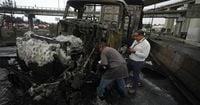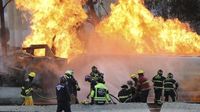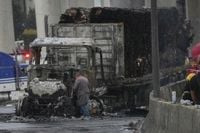On the afternoon of September 10, 2025, Mexico City was rocked by a catastrophic explosion when a gas tanker truck overturned and burst into flames beneath a busy highway overpass. The blast, which authorities have described as one of the most severe in recent memory for the capital, killed three people and left at least 70 others injured, some with life-threatening burns. The sheer scale of the disaster, its harrowing aftermath, and the questions it has raised about transport safety have gripped the nation and brought the city’s emergency response capabilities into sharp focus.
The incident unfolded on one of Mexico City’s most vital arteries, Ignacio Zaragoza Avenue, a major route leading southeast out of the city toward Puebla. According to multiple reports, including those from The Associated Press and Reuters, the tanker was hauling more than 13,000 gallons (49,500 liters) of gasoline when it tipped over under the overpass, likely due to a loss of control. Within moments, a cloud of leaking gas ignited, triggering a massive explosion that sent flames and thick plumes of smoke billowing over the city’s southern skyline.
Mayor Clara Brugada, who rushed to the scene, called the explosion an “emergency” and described the devastation as “a horrible accident.” She confirmed to reporters and on social media that three people had died and 70 had been injured, with 19 of those in grave condition, including the truck’s driver. Among the wounded were a baby and a 2-year-old child, underscoring the indiscriminate nature of the tragedy. The mayor pledged continued medical support for all victims, stating, “We will continue to provide medical support to the victims of this incident.”
The blast’s impact was immediate and overwhelming. Nearly 30 vehicles were engulfed in flames, with some reports indicating at least 18 to 30 cars and trucks destroyed or severely damaged. The explosion occurred at the border between the densely populated Iztapalapa district and Chalco, in neighboring Mexico State. Iztapalapa alone is home to 1.8 million residents, and the chaos that followed was palpable. Videos and images shared by authorities and circulated widely online showed a mushroom cloud of fire erupting from beneath the highway, with people fleeing in panic and emergency sirens wailing in the background.
Eyewitness accounts described scenes of horror: victims with charred clothing, some with their faces burned, emerging from the flames in shock. Lists of those injured revealed that some had suffered burns over nearly 100% of their bodies. As emergency vehicles raced to the site, local residents and passersby sprang into action, pulling victims from burning vehicles and carrying them to safety, even as the fire raged around them. According to The Associated Press, “groups of neighbors ran [and] helped pull burn victims from the fire and get them to safety.”
Firefighters and emergency personnel arrived quickly, battling the inferno with hoses and foam. The city’s fire department reported that the flames were completely under control by the evening, and that they had managed to burn off the remaining gas in the tanker—estimated at about 20,000 liters (approximately 5,300 gallons)—without further incident. Judith Rodríguez Vargas, a spokesperson for the fire department, noted that authorities had removed the truck from the scene later that night. The affected roadway, a crucial link for commuters and freight traffic, was reopened by evening, though the scars of the disaster were still visible in the charred remains of vehicles and the blackened overpass structure.
The investigation into the cause of the accident began almost immediately. Prosecutors, as confirmed by Mayor Brugada and reported by The Hindu and Reuters, are probing the circumstances that led to the truck tipping over and the subsequent explosion. Preliminary findings suggest that the tanker’s loss of balance was the triggering event, but officials have not ruled out the possibility of mechanical failure or human error.
The tanker itself bore the logo of Silza, a well-known energy company in the region. However, the company quickly denied ownership of the vehicle in a call with The Associated Press, and did not respond to further requests for comment. The plot thickened when Mexico’s environmental ministry revealed that Silza’s application for updated insurance paperwork required to transport gas had been rejected, meaning the truck was operating without the necessary legal coverage. This revelation has intensified scrutiny of regulatory oversight and the enforcement of safety standards for hazardous materials transport in Mexico.
President Claudia Sheinbaum expressed her condolences to the families of those killed and praised the efforts of emergency teams in a post on X, formerly known as Twitter. Her message echoed the sentiments of a city and nation mourning the loss of life and grappling with the trauma inflicted on survivors and witnesses.
The explosion has also reignited debates about the risks posed by the transport of flammable materials through densely populated urban areas. This incident marked the second major highway accident in Mexico that week, raising alarms about systemic issues in road safety and the regulation of fuel transport. Residents of Iztapalapa and Chalco have voiced concerns about the frequency of heavy truck traffic and the apparent lack of robust safety protocols. “It is a tragic accident. The prosecutor’s office is beginning investigations to determine what happened,” Mayor Brugada stated at the scene, acknowledging the urgency of addressing these longstanding issues.
For many, the images of the aftermath—burned-out vehicles, stunned survivors, and the tireless work of firefighters—will linger long after the scene is cleared. The city’s rapid emergency response, with medics, firefighters, and ordinary citizens working side by side, has drawn praise. Yet, as the investigation continues and the victims begin the long process of recovery, pressing questions remain about accountability, prevention, and the safety of Mexico City’s roads.
As families mourn and the wounded fight for their lives, the city faces a reckoning with the dangers that lurk on its highways. The events of September 10 serve as a stark reminder of the human cost of lapses in safety and the resilience of a community in the face of tragedy.



